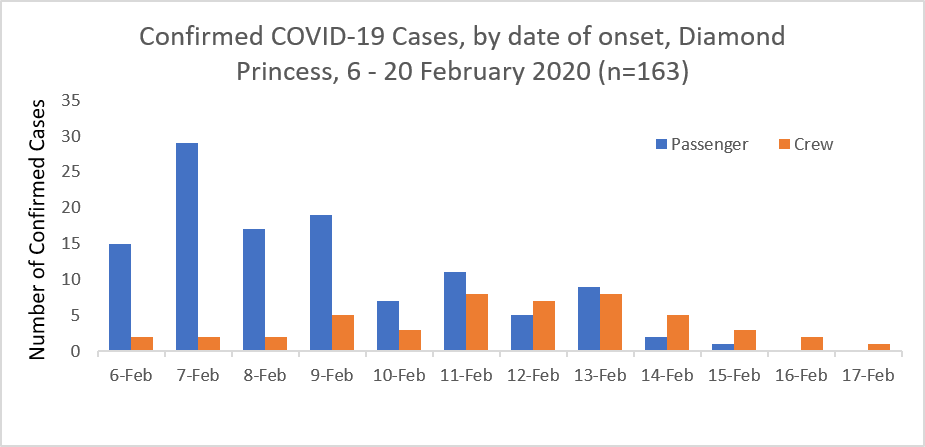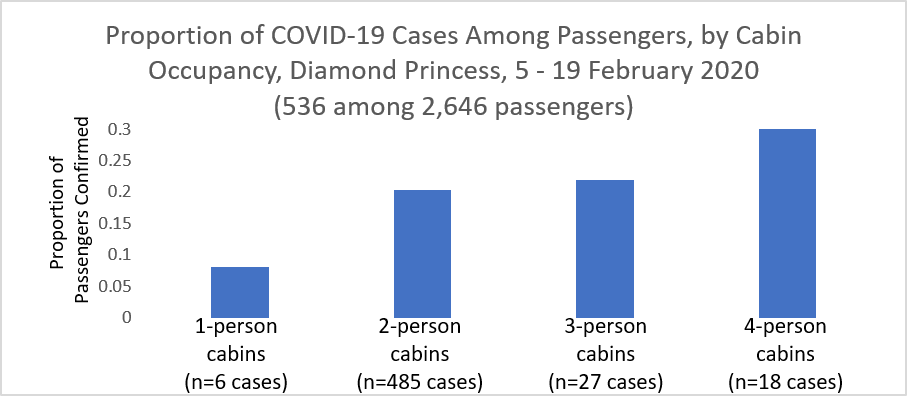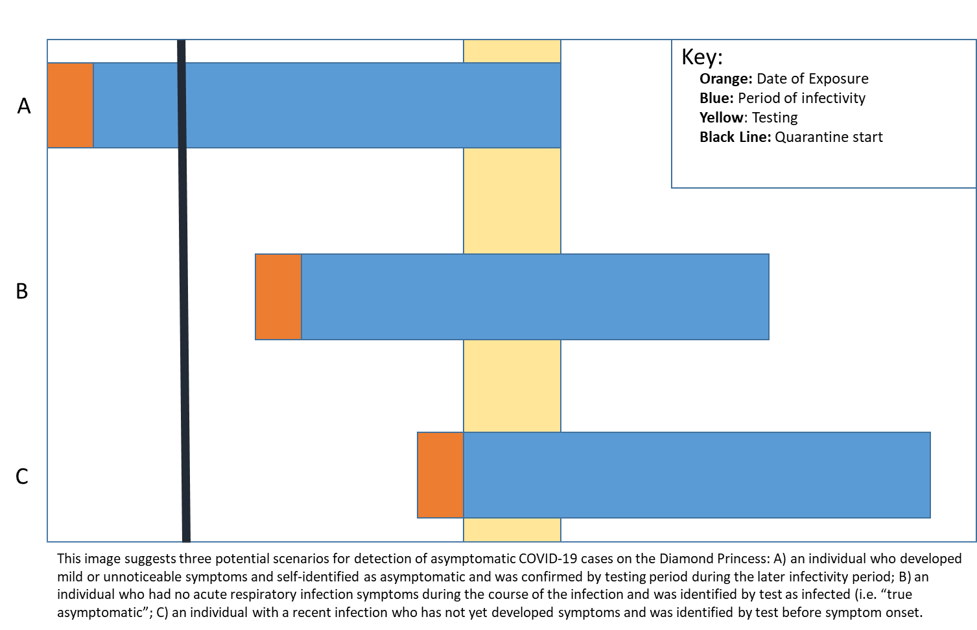Field Briefing: Diamond Princess COVID-19 Cases, 20 Feb Update
Background:
Please refer to Field Brief: Diamond Princess COVID-19 Cases (https://www.niid.go.jp/niid/en/2019-ncov-e/9407-covid-dp-fe-01.html).
Quarantine Measures:
The initial quarantine period for those onboard the Diamond Princess was 5-19 February, with passengers informed that the 14-day quarantine could be extended if they were exposed to additional risk, for example close contact with a confirmed COVID-19 case. Additional details on quarantine measures can be found in “Field Briefing: Diamond Princess COVID-19”.
Disembarkation Procedures:
Criteria for disembarkation of non-cases from the Diamond Princess included 1) completion of a 14-day period without sharing a cabin with a confirmed case; 2) a negative result for a SARS-CoV-2 by PCR in the final days of the period; and 3) no relevant symptoms identified during a medical screening in the final day of the period. As of 20 February, over 1600 individuals have been disembarked from the Diamond Princess. Initially, testing focused on high-risk persons. Beginning on 11 Feb, efforts shifted toward testing all passengers by PCR for SARS-CoV-2. Due to the number of persons on board, these efforts began with passengers over 80, then over 75, then over 70, etc. After all passengers had been tested, the focus shifted to testing all crew members. Although no international guidelines require PCR testing to clear a quarantine for COVID-19 outbreaks, the Japanese government sought to do so as an additional measure of assurance.
Data Collection:
In addition the data collection methods described in Field Brief: Diamond Princess COVID-19 Cases; retrospective data collection has also begun by gathering information from the ship’s onboard clinic. Data here have been analysed descriptively.
Preliminary Results:
As of 20 February, 619 cases have been confirmed (16.7 % of the population on board), including 82 crew and 537 passengers. A total 3011 respiratory specimens were tested, and 621 were positive (20.6%), including double tests. Persons aboard between 70 and 89 were the most affected (Table 1). Among confirmed COVID-19 cases with recorded symptom onset (n=197), there were 34 (17.3 %) with onset dates before 6 February, which was the first full day of quarantine, and 163 (82.7%) with onset dates on or after the 6th (Figure 1). Among these 197 cases, 163 occurred during the quarantine period (48 crew, 115 passengers), with 52–92 among passengers in cabins without a previously confirmed case (Table 2). Of these, 3–7 occurred after the median quarantine day (day 7). The proportion of COVID-19 cases confirmed among passengers increased with cabin occupancy (Figure 2). A total 318 (51%) of all confirmed cases were asymptomatic when the respiratory specimen was collected (10 crew and 308 passengers).
Preliminary Conclusions:
Based on current available epidemiologic information, there is clear evidence that substantial transmission of SARS-CoV-2 was occurring prior to arrival of Diamond Princess in Yokohama. The subsequent decline in the number of confirmed cases with reported onset dates, may be explained by the natural course of the outbreak, by the implementation of quarantine measures, or by other unknown factors. Based on the cabin occupancy findings and the number of cases identified in cabins with previously confirmed cases, passengers within cabins may have been exposed to a common source or may have transmitted the virus within cabins. Due to the nature of the ship, individual isolation of all those aboard was not possible. Sharing cabins was necessary, and some crew had to perform essential duties while passengers remained aboard. After accounting for delayed reporting, the peak number of confirmed cases with known onset dates occurred on 7 February. The high number of recently reported cases can be explained by the shift in testing strategy described above, most of which were asymptomatic.
The proportion of asymptomatic cases observed aboard Diamond Princess is substantially higher than what has been reported elsewhere. A major factor in this proportion is the systematic testing of passengers that began on 11 Feb and increased each day. Due to the lack of symptom presentation, it is not possible to infer when these cases were infected (see Annex A). Some may have been secondary cases within a given cabin. Some may have been infected before the quarantine began. Nevertheless, these asymptomatic cases were detected through testing, disembarked, and transferred to isolation. Their cabin mates have been defined as close contacts with their 14-day isolation reset on the last day the asymptomatic case disembarked. The systematic testing of asymptomatic cases was therefore important and beneficial for identifying potentially infectious individuals before allowing them to disembark. Current global research has scant evidence on asymptomatic transmission of SARS-CoV-2; thus, ongoing efforts to thoroughly investigate asymptomatic cases from Diamond Princess will provide important information for the global COVID-19 outbreak. (Information on the development of symptoms after disembarkation of asymptomatic confirmed cases is being collected.)
Surveillance staff are working on merging the data from Diamond Princess with information from reported COVID-19 cases in the National Epidemiological Surveillance of Infectious Diseases (NESID) to understand more about the clinical presentation, severity and initial asymptomatic presentation. This information will be important for further the understanding this event and the global situation of COVID-19.
Preliminary Actions/Guidance:
Nearly all disembarked individuals have observed a 14-day quarantine without sharing a cabin with a confirmed case, have received a recent negative PCR-test, and have passed a medical screening for symptoms (e.g. fever, cough,). Individuals who shared a cabin with a confirmed case will be put in isolation until they complete a 14-day beginning after the last day of contact with a confirmed COVID-19 cabinmate. This includes a large proportion of the crew, who admirably performed essential tasks that allowed the quarantine to occur and should be appreciated for their service. As more than 1600 individuals, primarily passengers, have been disembarked from Diamond Princess, the focus and support will now shift toward preventing further transmission of SARS-CoV-2 among crew.
Although the disembarked persons have passed laboratory testing, medical screening and the 14-day quarantine, they are asked to stay at home, where feasible, 14 days unless absolutely necessary, as an additional precautionary measure. They are asked also to monitor themselves for symptoms and contact a a healthcare facility if symptoms develop.
Note: this work would not have been possible without the important efforts of medical teams who went aboard Diamond Princess to care for passengers and crew and obtain this necessary information; the efforts of the crew to provide essential services; and the collaboration of Princess Cruises.
Table 1. Percent of persons aboard confirmed with COVID-19 by age group and symptom status at the time of specimen collection. (As of 20 February).
|
Age group |
Symptomatic confirmed cases (%) |
Asymptomatic confirmed cases (%) |
Total confirmed cases (%) |
Persons aboard on 5 February |
|
00-09 |
0(0) |
1(6) |
1(6) |
16 |
|
10-19 |
2(9) |
3(13) |
5(22) |
23 |
|
20-29 |
25(7) |
3(1) |
28(8) |
347 |
|
30-39 |
27(6) |
7(2) |
34(8) |
428 |
|
40-49 |
19(6) |
8(2) |
27(8) |
334 |
|
50-59 |
28(7) |
31(8) |
59(15) |
398 |
|
60-69 |
76(8) |
101(11) |
177(19) |
923 |
|
70-79 |
95(9) |
139(14) |
234(23) |
1015 |
|
80-89 |
27(13) |
25(12) |
52(24) |
216 |
|
90-99 |
2(18) |
0(0) |
2(18) |
11 |
|
Total |
301(8) |
318(9) |
619(17) |
3711 |
Figure 1. Number of confirmed COVID-19 cases* with reported onset dates, by onset date, aboard Diamond Princess, 6 – 20 February 2020 (n=163)

* The number of cases (n = 163) was based on the cases with available onset date reported.
Figure 2. Comparison of proportions of confirmed cases among passengers by cabin occupancy.

Table 2. Characteristics of COVID-19 Cases with reported on-set dates of 6 – 17 Feb 2020 (n=163).
|
Day of Quarantine |
Date of Onset (n cases) |
Crew |
Passengers |
||
|
Total |
In cabins with a confirmed case |
In cabins without a confirmed case |
|||
|
12 |
17 Feb (1) |
1 |
0 |
0 |
0 |
|
11 |
16 Feb (2) |
2 |
0 |
0 |
0 |
|
10 |
15 Feb (4) |
3 |
1 |
0 [1] |
0-1 |
|
9 |
14 Feb (7) |
5 |
2 |
1 [0] |
1 |
|
8 |
13 Feb (17) |
8 |
9 |
4 [3] |
2-5 |
|
7 |
12 Feb (12) |
7 |
5 |
0 [2] |
3-5 |
|
6 |
11 Feb (19) |
8 |
11 |
3 [1] |
7-8 |
|
5 |
10 Feb (10) |
3 |
7 |
3 [1] |
3-4 |
|
4 |
9 Feb (24) |
5 |
19 |
6 [9] |
4-13 |
|
3 |
8 Feb (19) |
2 |
17 |
1 [7] |
9-16 |
|
2 |
7 Feb (31) |
2 |
29 |
4 [10] |
15-25 |
|
1 |
6 Feb (17) |
2 |
15 |
1 [6] |
9-14 |
|
|
Total |
48 |
115 |
23 [40] |
52-92 |
The number in brackets represents the number of additional confirmed cases in the same cabin with unknown onset date. Due to the uncertainty of knowing which case came first, the column to the far right presents a range.
Annex A. Theoretical depiction of the identification of asymptomatic cases during the quarantine period.
